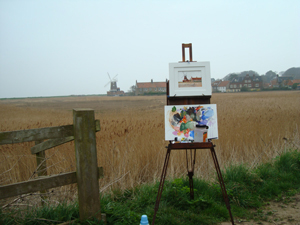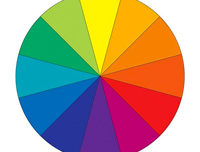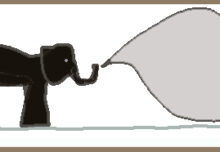PLEIN AIR
‘Plein air’ painting is the act of painting outdoors. But why is it at all interesting and relevant where the art was created? There are three main reasons. Firstly the light is different. Secondly the method is different. And thirdly the subject is different. And these three factors have influenced what all art looks like.

plein air at Cley 3 April 09
THE LIGHT IS DIFFERENT
Daylight is much bluer than artificial light. Most people don’t realize this because human eyes are so good at adjusting subconsciously without a problem. People think that red is red and orange is orange wherever it is. But it isn’t. Photography can give us a clue because camera lenses are inhuman image recorders and just capture what is there. But of course when most humans look at photographs they make the adjustment unconsciously and don’t usually see that outdoor light is bluer than indoor light. But artists have to try to mix and match colours and they must be aware of the fact that outdoor light is colder and bluer.
So why is this interesting and relevant? Because landscapes etc. are outdoors, and they will usually hang on walls indoors.
Plein air painting is a very good way for artists to become aware about light and perspective and other factors. When an artist actually goes out and tries to match colours and tones they find that things in the distance are smaller, and fuzzier, and fainter, and more purple. Aerial perspective becomes obvious. Nearer things are bigger, brighter, greener, crisper, and stronger. Plein air painting has the effect of making artists become aware of what things actually look like.
THE METHOD IS DIFFERENT
Oil paint takes a very long time to dry. Carrying a wet oil painting home on the bus is still a bit tricky. Just imagine the problems when artists had to move around on foot or in a horse and cart.
When artists paint became available in tubes the world changed. That was in the late 1800’s. Obviously in the dark ages before the supply of paint tubes an artist wishing to paint outdoors would have had a problem. They could sketch using mono-chromatic material on paper perhaps. Previously pencil, crayon, charcoal, sketches were for artist’s own use and were not considered a finished art product.
Water-colours on paper are much safer and full colour is possible. Artists suppliers created water colour boxes with pans and tubes of colour. Plus they made sketch pads and books of quality watercolour paper. As a result finished art-works using water-colour paints have become quite acceptable. They have even become the norm for landscape in some portfolios.
Another factor is the size of the artwork. A big canvas may be quite practical in a large studio space but outside in the open air it becomes a nightmare. A slight breeze can send painting and easel away across a field or railway-line or into the sea. So artists learn how to manage with small or small-to-medium size canvases. This has had the effect of changing the subject content of the artwork.
THE SUBJECT IS DIFFERENT
Landscapes, cityscapes, and seascapes are outdoors. Distance is a fact outdoors. Weather plays an important role because the light, shadows, and movement factors constantly change what is in front of the artist’s eyes. That is so different to the set up inside a studio where the light is constant and the still life or portrait sitter stay the same for hours. Artists working outdoors have to act quickly. And they have to notice relevant things quickly. So artists speed up, and they make mistakes, and they adjust their painting style.
Turner opened up the eyes of onlookers to the merits of water-colour landscape sketches.
Then later, whole movements like Impressionism came about because artists were painting outside, plus they were painting quickly. Crucially they were painting outside using watercolours or oil in tubes.
LATER AND LATEST FACTORS
Photography enables an artist to capture the landscape, cityscape, seascape etc. Then work on the image back in the studio.
Acrylic paint has much of the same tactile quality as oil paint, but it dries much quicker because it is water based. It can be painted onto paper, or canvas, or board, or almost anything handy. So acrylics really enable artists to use colour and texture while outdoors.
IPads or other tablets can be used by artists to get spectacular on the spot digital effects as well. A tablet can also take a simultaneous photo. But the finger painting software available adds a new creative dimension. These plein air images can be blown up to much bigger sizes, manipulated, cropped, and much more. A great exponent is David Hockney.
CONCLUSION
The different light, method, and subject applicable to plein air painting has had a profound effect on the history of art during the last couple of centuries. The major art movement of Impressionism was a direct result. Other effects have been on acceptable size and subject matter of paintings, plus watercolour is not just a sketch medium.
The changes are still carrying on with new techniques like tablet art. We live in exciting times.




